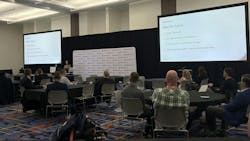Nicole Dyehouse Highlights NBAA’s Five Steps for Success for Operators at BACE 2025
Key Highlights
- Digital records enable scalable safety practices, allowing teams to identify hidden risks, streamline documentation and leverage AI for proactive safety management.
- Engaging all team members in planning and decision-making fosters a collaborative safety culture, with shared dashboards and clear communication improving accountability and hazard detection.
- Integrating maintenance data into risk assessments and safety processes helps uncover hazards related to aircraft airworthiness, supporting better real-time decision-making.
Nicole Dyehouse, founder and CEO of planeKrafty, educated attendees of NBAA BACE 2025 about the organization’s Five Simple Steps to a Safer Small Flight Operation.
Dyehouse noted, “It came from the NBAA’s Domestic Operations Committee. They put together the five simple steps so that safety can be a focus for teams of all sizes.”
What are the Five Simple Steps?
Dyehouse reviewed the Five Simple Steps outlined on the NBAA’s website, which are:
- Implement Briefings and an Aviation Safety Action Program (ASAP)
- Implement a Flight Risk Assessment Tool
- Adopt Standard Operating Procedures (SOP) and Emergency Response Plans (ERP)
- Implement a Safety Management Process (SMP)
- Implement Safety Audits and Flight Monitoring Devices
Dyehouse touched on the implementation of these steps, stating, “That’s always been very difficult in the current environment with which most people operate, which is physical records. The digital game changes all of that. It means that you can actually do this at scale without sacrificing precious human resources you already are struggling to keep on board.”
Dyehouse continued, “These are all action statements, right? And to do anything well, there's the saying that I've heard about so long ago: Proper planning prevents poor performance. So, you have to plan. There's a simple acronym, POEM: plan, organize, execute, monitor. Then, use the data from that monitoring to influence the next plan. That's how you evolve.”
She added, “And while these are all execution steps, in order to do them well, you'll need some planning and organization, which means team engagement. It means thoughtfulness and ensuring that you're actually getting at the details of the problems that you need to solve.”
How to implement briefings and an aviation safety action plan (ASAP)
Dyehouse began discussing the significance of briefings and ASAP program use, especially when transitioning to digital record-keeping methods, asserting, “Briefings aren't just for pilots; they’re for mechanics too. When you have digital records, you can unlock the hidden risk that's buried in there, re-writeups, movements on parts issues or release, and you can also integrate it with your ASAP program.”
She continued, “The transparency with maintenance records and bringing that digital opportunity into the piece, as we can see the rise of AI and the ability to reliably interrogate those records, you can move the data from the maintenance record to the operational briefings and into the SMS. Data means prevention.”
One method that Dyehouse recommended to the audience was hosting a structured maintenance briefing to share data openly. She explained, “It can be 10 minutes a week. It doesn't have to be a heavy lift, at first. Simply identify the things that are most critical to you. Or maybe it's a simple win.”
She added, “Either way, a simple win will give you a little bit of momentum to keep going, or if you have a critical pain point, especially if it’s tied to a KPI or a metric that the company wants you to focus on, it's a lot easier to get engagement there, because when you can see the value, the value proposition is a lot easier to sell to your team.”
Why implement a flight risk assessment tool (FRAT)?
When presenting about flight risk assessment tools, Dyehouse emphasized how these tools should be used for reviewing maintenance documents.
She said, “Too often in the FRAT system, the maintenance or airworthiness is a little bit ignored. It's heavily focused on the crew and the weather, but there's a third leg there, and that's the maintenance documentation, the airworthiness of the aircraft.”
“When you integrate the maintenance data into the FRAT scoring, you can uncover hidden hazards, and it becomes scalable again with digital records, because the system can unlock and iterate the data that normally would take an enormous amount of human resource to get at,” Dyehouse noted.
“When a flight risk assessment tool integrates the airworthiness, the ops, and the crew, you're able to see things in real time with real updates that will lead you to better decision-making, because the best decisions are the ones where you have all the knowledge at your hands,” she added.
Why consider Standard Operating Procedures (SOP) and Emergency Response Plans (ERP)?
“The SOPs are not just a bunch of red tape,” Dyehouse stressed, “And if you feel like they're nothing but red tape, then that's someplace that you can revisit, because they should really be giving you good guidance so that in the event of an ERP, you have the framework to know how to handle that stressful situation, and you're not flying off-the-cuff.”
Dyehouse outlined the following questions for maintenance operators to consider when dealing with SOPs:
- What do you do with the records?
- Who takes care of it?
- When does it happen?
- Where do they go?
- Why are you doing it?
Dyehouse said, “And the why is really critical. Don't forget that step, because if people don't understand why they're doing something, they're probably a lot less likely to be very intentional about their movements there.”
Explaining the importance of taking these steps preemptively, Dyehouse warned, “Waiting until a critical event happens to write the SOP for an emergency scenario or an ERP is like waiting until your house is on fire to build a fire department.”
“It's just not the time, and when you do it in advance and really give it that thoughtfulness, engaging everybody who's a touchpoint to any given scenario, then you get the full buy-in, and you uncover any of the hidden risks that you're not going to be able to deal with if you wait until things go sideways,” she concluded.
How to implement a Safety Management Process (SMP)
When highlighting the importance of Safety Management Processes, Dyehouse noted, “The records aren't just documents; they're data points and data signals. Every maintenance action is a data point for an SMS.”
She continued, “Again, this is a lot easier to be scalable with digital records than with physical ones. And when maintenance trends integrate into the safety dashboard, you start to unlock the ability for predictive insights and methods, instead of waiting until a post-flight paperwork event.”
On why it’s key to keep everyone involved in an aircraft’s operation informed, Dyehouse said, “Pairing maintenance into the pilot-in-operations briefings is huge. That way, everybody knows what's affecting everyone else. And being empathetic in that engagement, really listening to what other people's problems are, will give you the opportunity to solve a problem you hadn't seen before, and vice versa.”
“Sharing your pain point with those other departments will help to raise you all together. Shared dashboards and shared language means shared accountability, and that's how you really develop and build a unified safety culture,” she added.
Why are safety audits and flight monitoring devices important?
“Records audits are safety audits,” said Dyehouse, “When they're digital and the intelligence is built into the application, it gets a lot easier, and it means you don't have to spend so much time fiddling around with a bunch of tiny details. All of the data becomes clear to you and is presented for your benefit.”
She proceeded, “When you have missing, incomplete or outdated login entries, you weaken your compliance, and you have a lot of hidden hazards. When you have repeated squawks or deferred MELs and part replacements, that's a lot of early risks signals.”
Offering a solution, Dyehouse explained, “Automated cross checks catch gaps in the AD and service bulletin compliance, and inspection tracking and MEL expirations. Data feeds back into the operations briefing and risk assessments and organizational safety management systems.”
“The takeaway is that you cannot manage what you do not measure. You have to be intentional about it, and you have to bring your team into the conversation,” she added, “You have to normalize the process. Consistency beats intensity every day. Celebrate the wins, whether it's a cleaner logbook or a tighter SOP or the 10-minute briefing that highlighted or exposed something that would have otherwise gone unnoticed.”
Dyehouse also gave examples of questions to ask during the proposed 10-minute briefing to get the ball rolling, such as:
- What are the top two things that suck your time daily?
- What's the biggest safety issue you've seen in the last 30 days?
Dyehouse instructed, “Pick one of those critical things and send somebody off to find some data about it that will be effective in resolving that issue. Maybe your first pass, isn't the right one, but when you do stay consistent and you stay safety forward and you stay organized, you will eventually find your rhythm.”
In the age of digitalization in MRO and all across aviation, Dyehouse noted, “Tech is here to not replace us, but to support us. When you collect the data, use it.”




